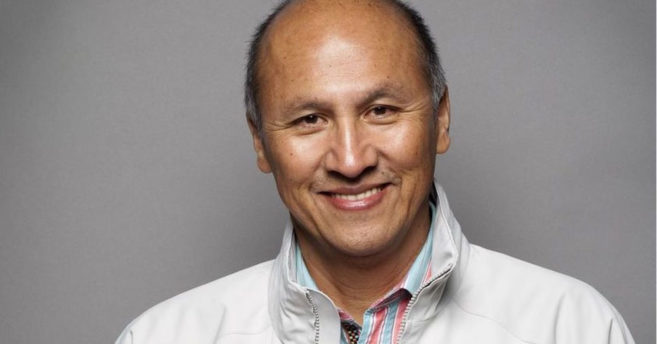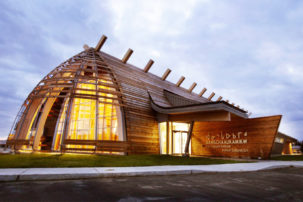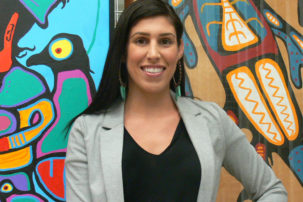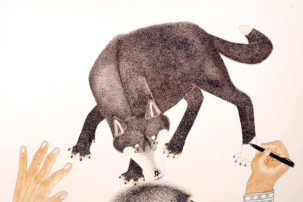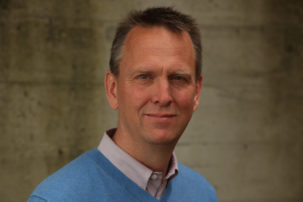Wanda Dalla Costa: the first First Nations woman in Canada to become a registered architect. Patrick Stewart: the first person of First Nations ancestry elected as President of the Architectural Institute of British Columbia. Harriet Burdett-Moulton: the founder of the first design firm in the Eastern Arctic, and builder of more than 150 projects in the world’s harshest environment.
These are just 3 of the 18 Indigenous architects and designers brought together in “Unceded: Voices of the Land” at the Venice Architecture Biennale, which opens to the public on Saturday.
And like the talents it gathers, “Unceded” is, itself, another kind of first—namely, the first-ever Indigenous-led entry to be presented by Canada at the Venice Architecture Biennale.
 A view of “Unceded: Voices of the Land.” Photo: Cueyo Laux.
A view of “Unceded: Voices of the Land.” Photo: Cueyo Laux.
The exhibition is presented by iconic architect Douglas Cardinal, whose buildings include the National Museum of the American Indian and the Canadian Museum of History. And it is co-curated by Siksika curator Gerald McMaster—who in 1995 curated Ed Poitras as the first presentation by an Indigenous artist at Venice Biennale’s Canada Pavilion—as well as by Métis architect David Fortin, who is the first Indigenous architect to become a director of a Canadian school of architecture.
“For a lot of years in architecture, there was always a pressure to conform to Western traditions; there wasn’t really any celebration of Indigenous cultures, and you couldn’t see yourself in what was being celebrated as good architecture,” says co-curator David Fortin in a phone interview. “I think we are starting to question that in this exhibition.”
 A view of “Unceded: Voices of the Land.” Photo: Cueyo Laux.
A view of “Unceded: Voices of the Land.” Photo: Cueyo Laux.
“Unceded” explores four key themes: indigeneity, resilience, sovereignty and colonization. This sets “Unceded” apart from many other architectural exhibitions, especially ones seen at large biennials like Venice.
“The modular Indian Affairs home, which looks the same in every Indigenous community, has kind of wrested [Indigenous] identity out of Indigenous communities,” says co-curator Gerald McMaster in a phone interview, speaking to one way that colonization has affected Indigenous architects. “The federal government and the Department of Indian Affairs has long been the authorial voice, and so what architects and designers and artists are doing is taking voice back and speaking for themselves rather than having others speak for us…They are starting to look at what Indigenous design means in Indigenous lands and Indigenous spaces.”
 A view of “Unceded: Voices of the Land.” Photo: Cueyo Laux.
A view of “Unceded: Voices of the Land.” Photo: Cueyo Laux.
“Unceded” also conveys its themes in a very unique manner for architectural exhibition-making—it uses a huge, curving screen filled with motion graphics, life-sized videos and soundscapes rather than a spread of pro forma maquettes, sketches and material samples.
“I think what is interesting is that we are talking about architecture through storytelling, which is more of an Indigenous framework for communicating things,” says Fortin, noting that traditionally, Indigneous architectural forms were conveyed orally rather than through models or sketches. “When you walk through the exhibit, the buildings are part of telling stories of the landscape—you are hearing the water, you are hearing the drums, you are immersed in buildings as living things. You can’t just pull buildings out as objects; they have to be woven into the landscape.”
“Unceded” is also playing host to ceremony and performance—aspects of living culture not often incorporated into architectural exhibitions.
Earlier this week, for instance there was a traditional ceremony in the space, says McMaster: “We had elders from Alberta, Saskatchewan, Ontario and Quebec… we had a smudging ceremony, and we had a small dance afterwards. I think that’s what the pavilion and exhibition is about; it’s about the people, the land, the culture the songs—everything that would have been stolen away from us at one time.”
Today, Red Sky Performance is in the “Unceded” space, performing a work called Miigis.
 A view of “Unceded: Voices of the Land.”
A view of “Unceded: Voices of the Land.”
Such events, as well as the general approach and design of “Unceded,” help resist the usual readings of an architectural exhibition.
“When architects are looking through exhibits like [the ones in the Biennale],” says Fortin, “you are often looking for something you can borrow or take away—you are looking for clues to inform your design. And in ours, there aren’t elements to take away…I think one of the messages is that Indigenous architecture can’t be stylized. You can’t just look at a pattern and then try to replicate it—because if you are not part of the story in meaningful ways, you can’t do that.”
And the story of “Unceded” continues to unfurl. In addition to being at the Venice Biennale until November 25, at least three North American institutions have already requested the possibility to exhibit it in 2019 and beyond.
It is all exciting news for a “Turtle Island team,” as McMaster puts it, that has focused on common languages rather than colonial 49th-parallel borders. “I hope that people will walk away understanding that Turtle Island is more than just these major, vast cities,” says McMaster, “and that Indigenous people inhabit every square mile of North America.”
“Unceded: Voices of the Land” runs May 26 to November 25 at the Venice Architecture Biennale. More information is available at unceded.ca.
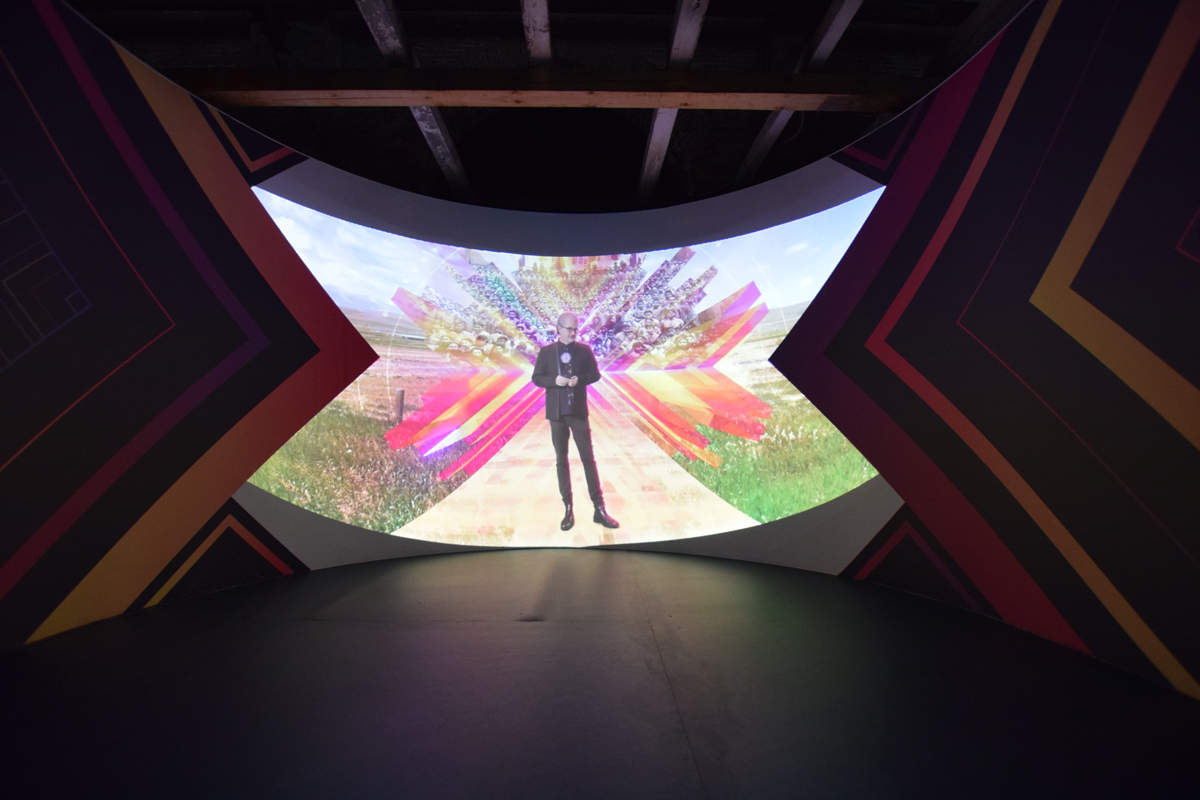 A view of “Unceded: Voices of the Land.” Photo: Cueyo Laux.
A view of “Unceded: Voices of the Land.” Photo: Cueyo Laux.
 A view of “Unceded: Voices of the Land.” Photo: Cueyo Laux.
A view of “Unceded: Voices of the Land.” Photo: Cueyo Laux.
 A view of “Unceded: Voices of the Land.” Photo: Cueyo Laux.
A view of “Unceded: Voices of the Land.” Photo: Cueyo Laux.
 A view of “Unceded: Voices of the Land.” Photo: Cueyo Laux.
A view of “Unceded: Voices of the Land.” Photo: Cueyo Laux.
 A view of “Unceded: Voices of the Land.” Photo: Cueyo Laux.
A view of “Unceded: Voices of the Land.” Photo: Cueyo Laux.
 A view of “Unceded: Voices of the Land.” Photo: Cueyo Laux.
A view of “Unceded: Voices of the Land.” Photo: Cueyo Laux.
 A view of “Unceded: Voices of the Land.” Photo: Cueyo Laux.
A view of “Unceded: Voices of the Land.” Photo: Cueyo Laux.


